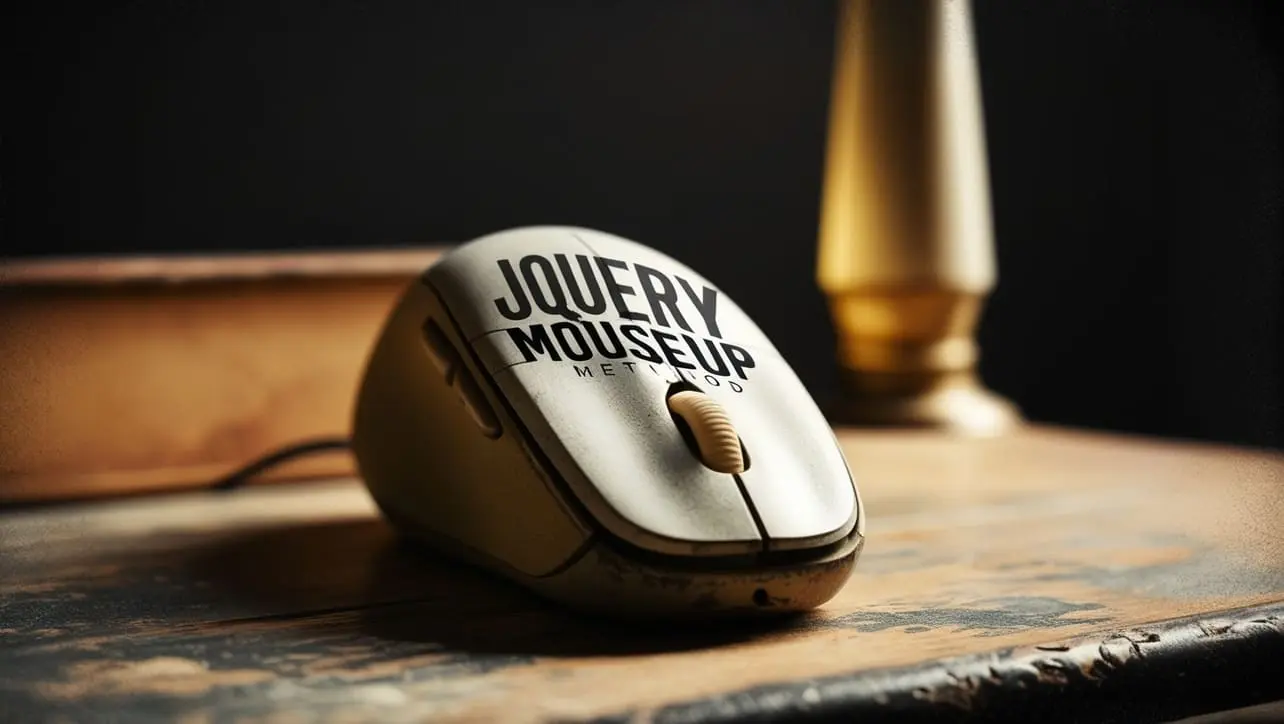
jQuery Topics
- jQuery Introduction
- jQuery Callbacks
- jQuery deferred
- jQuery selectors
- jQuery Ajax Events
- jQuery Ajax Methods
- jQuery Keyboard Events
- jQuery Keyboard Methods
- jQuery Form Events
- jQuery Form Methods
- jQuery Mouse Events
- jQuery Mouse Methods
- jQuery Event Properties
- jQuery Event Methods
- jQuery HTML
- jQuery CSS
- jQuery Fading
- jQuery Traversing
- jQuery Utilities
- jQuery Properties
jQuery .mouseup() Method

Photo Credit to CodeToFun
🙋 Introduction
In web development, user interaction plays a crucial role in creating engaging and dynamic experiences. jQuery provides a variety of methods to handle user events efficiently, and one such method is .mouseup(). This method allows you to execute a function when the mouse button is released after being pressed down on an element. Understanding how to utilize the .mouseup() method effectively can enhance your ability to create interactive web pages.
In this guide, we'll explore the usage of the jQuery .mouseup() method with clear examples to help you grasp its functionality.
🧠 Understanding .mouseup() Method
The .mouseup() method in jQuery is used to bind an event handler to the "mouseup" JavaScript event. This event occurs when the mouse button is released after being pressed down on an element.
💡 Syntax
The syntax for the .mouseup() method is straightforward:
$(selector).mouseup(function)Parameters:
- selector: A selector expression to specify the elements to which the event handler should be attached.
- function: The function to execute when the mouse button is released.
📝 Example
Executing Function on Mouse Button Release:
Suppose you want to display an alert message when the mouse button is released after being pressed down on a specific element. You can achieve this using the
.mouseup()method as follows:index.htmlCopied<button id="myButton">Click Me</button>example.jsCopied$("#myButton").mouseup(function() { alert("Mouse button released!"); });This will trigger an alert message when the mouse button is released after clicking the button with the ID myButton.
Changing CSS on Mouse Button Release:
You can also change CSS properties of elements when the mouse button is released. Here's an example where we change the background color of a div element:
index.htmlCopied<div id="myDiv" style="width: 100px; height: 100px; background-color: lightblue;"></div>example.jsCopied$("#myDiv").mouseup(function() { $(this).css("background-color", "lightgreen"); });This will change the background color of the div to light green when the mouse button is released after being pressed down on it.
Performing Advanced Operations on Mouse Button Release:
You can perform more complex operations using the
.mouseup()method, such as updating data or triggering other events. For instance:example.jsCopied$("#myInput").mouseup(function() { // Perform advanced operations here });Replace #myInput with the appropriate selector for your element, and execute the desired operations within the function.
🎉 Conclusion
The jQuery .mouseup() method provides a convenient way to handle events triggered by the release of the mouse button. Whether you need to execute functions, change CSS properties, or perform advanced operations, this method offers flexibility and ease of use.
By mastering its usage, you can create more interactive and responsive web pages that enhance the user experience.
👨💻 Join our Community:
Author

For over eight years, I worked as a full-stack web developer. Now, I have chosen my profession as a full-time blogger at codetofun.com.
Buy me a coffee to make codetofun.com free for everyone.
Buy me a Coffee












If you have any doubts regarding this article (jQuery .mouseup() Method), please comment here. I will help you immediately.